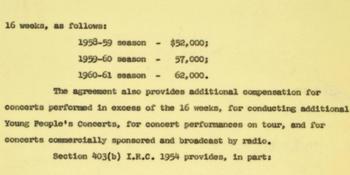
Leonard Bernstein was paid rather modestly at first: A memo from the Philharmonic’s law firm details Bernstein’s three-year contract with the orchestra for the 1958-1961 seasons. For a 16- to 20-week annual commitment with the orchestra, he was paid $52,000 in 1958-69, $57,000 in 1959-60, and $62,000 in 1960-61. Adjusted for inflation, his starting salary is equivalent to $396,249 in 2011, with a final salary of $472,450. In all, a far cry from today's seven-figure conductor salaries.
(New York Philharmonic Digital Archives)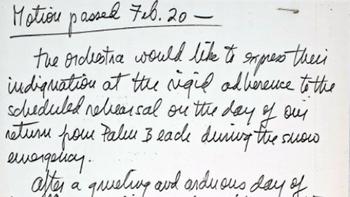
Snowstorms were as contentious in the '60s as they are today.
On February 20, 1969, the musicians protested a rehearsal after returning from Florida. “The orchestra would like to express their indignation at the rigid adherence to the scheduled rehearsal on the day of our return from Palm Beach during the snow emergency,” their motion reads. “After a grueling and arduous day of traveling, involving circling with indecision over two airports, and a dangerous landing, plus waiting at the airport in the cold and wet for buses, we were sent on stage for an unnecessary rehearsal, as proven by the next day’s rehearsal.”
(New York Philharmonic Digital Archives)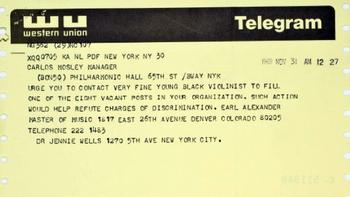
Later in 1969, two black musicians filed a complaint with the New York State Commission on Human Rights, charging the Philharmonic with discrimination and asking that the orchestra audition musicians behind a screen (the orchestra had just one black member at the time). The National Urban League also weighed in, calling on the orchestra to put affirmative action in place. The archives detail a seemingly anxious search for black candidates in the months that followed, as the orchestra corresponded with conservatories, foreign orchestras and other industry leaders. The above telegram follows one such inquiry.
(New York Philharmonic Digital Archives)
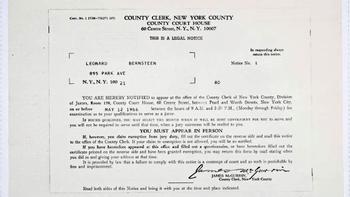
Even maestros get called for jury duty. A summons asks "Leonard Bernsteen" to appear in County Court at 60 Centre Street on May 12, 1966.
(New York Philharmonic Digital Archives)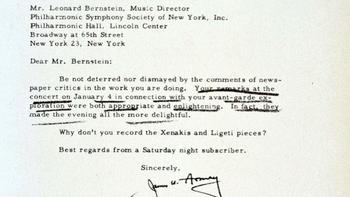
In 1964, Leonard Bernstein was the subject of fierce attacks from New York's music critics for what they took to be a poorly planned Philharmonic series examining the latest trends in the orchestral avant-garde. Harold Schonberg, the New York Times critic, deplored the way Xenakis and Ligeti were "snugly fitted" between Beethoven and Saint-Saens. Bernstein reportedly gave a 20-minute hard-sell introduction that the critics found too folksy, too condescending. Still, not everyone was displeased. The archives contain a series of letters from Philharmonic subscribers praising Bernstein's willingness to challenge audiences, including this one.
(New York Philharmonic Digital Archives)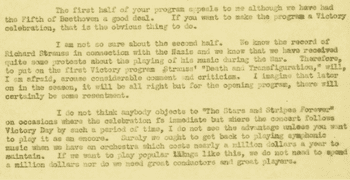
Nazi connections: An August 28, 1945 letter from general manager Arthur Judson to music director Arthur Rodzinski expresses concern over a program designed to celebrate the Allied Victory. Of particular concern was a piece by Richard Strauss, who, for complex reasons, was known to cooperate with the early Nazi regime.
“I am not so sure about the second half," it reads in part. "We know the record of Richard Strauss in connection with the Nazis and we know that we have received quite some protests about the playing of his music during the war. Therefore, I am afraid to put on the first Victory program Strauss’s 'Death and Transfiguration,' which will, I am afraid, arouse considerable comment and criticism. I imagine that later on in the season it will be all right but for the opening program, there will certainly be some resentment."
(New York Philharmonic Digital Archives)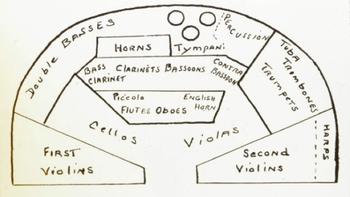
An undated stage plot shows just how much the seating arrangement of the orchestra has changed over the decades. Today, the cellos and bases sit to the conductor's right, for instance, while the trumpets and trombones form a single row.
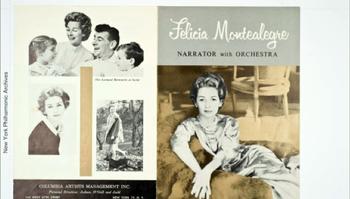
Bernstein's wife, the actress Felicia Montealegre, was hired several times as a narrator for Philharmonic programs of the 1950s and 60s. The above flyer not only lists her repertoire -- including works by Stravinsky, Prokofiev, Honneger and Foss -- but also details her "glamorous" family life. "As Mrs. Leonard Bernstein in private," it reads, "she is not only one of New York's most charming and popular hostesses, but she is also counted among America's best dressed women."
